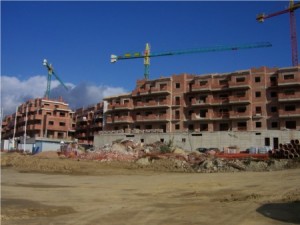
The Spanish property market has begun to turn the heads of foreign investors in 2013
For symbols of Spain’s post-recession woes, take your pick: most media outlets have chosen to focus on the lengthy queues snaking out of job centres up and down the country, but images of protesting students, boarded-up shops and beggars on the streets have just the same impact.
However, one stock image that no longer rings quite so true is that of construction cranes standing still and obsolete in unfinished developments across Spain. It’s true that some developments remain unfinished and unlikely to be finished, but as a symbol of Spain’s woes, the struggles of the construction industry are no longer an accurate representation…
Foreign investment in Spanish property has experienced something of a mini renaissance in 2013, with confidence returning to the sector for the first time since 2008, fuelled by a 30 per cent average price reduction and a state takeover of many of the country’s debt-ridden banks.
With an estimated 650,000 homes unsold, the construction industry is unlikely to enjoy its shares of the emergent spoils, but the renewed display of confidence among some foreign investors is a cause for optimism.
Many of Spain’s banks severely cut back on their mortgage credit, falling from a lending peak of €173 billion a year in 2007, to just €26 billion in 2013. The difference this year, however, is that many of the investments have been made by traditionally conservative and risk-averse investors, leading to speculation that the ‘smart money’ is being spent in Spain.
A number of private equity groups have ploughed money into Spanish property in the past few months, such as HIG Capital and Blackstone, the former investing a large stake in property belonging to Spain’s ‘bad bank’, Sareb. The Financial Times also reports that a handful of other large investors have been investigating real estate in Madrid and Barcelona after being put off by extortionate prices in London and Paris.
“There are quite a lot of family offices and investment funds with very long investment horizons that are looking closely at Spanish real estate,” the managing director of law firm Alvarez & Marsal, José de Ochoa, told the Financial Times. “The size of the deals are small so far, but I expect this to pick up significantly in the next year.”
Since the Spanish government introduced a provisioning round for banks, which forced them to write down the value of their bad loans and raise the appropriate capital to cover any expected losses, property transactions have increased. Allied to the introduction of Sareb, as much as €54 billion in troubled property loans have been removed from the balance sheets of Spain’s biggest banks. Investors have responded positively to this new, more secure setup, while the banks have been encouraged to sell off their stock at more reasonable prices.
“The banks need to sell their stock, and the bad bank is being very active in selling portfolios, which means there are several large players who are in a selling position,” Victor Casarrubios, partner at Madrid law firm Jones Day said to the FT. “On the other side, there are buyers expecting to find low prices and high rental yields, but this gap may become smaller as time goes on.”
 en
en



 Vlaams-Nederlands
Vlaams-Nederlands
0 Comments
Leave a Comment
DISCLAIMER
The opinions and comments expressed by contributors to this Blog are theirs alone and do not necessarily reflect the views of VIVA Homes Under the Sun Ltd, any of its associated companies, or employees; nor is VIVA to be held responsible or accountable for the accuracy of any of the information supplied.
Have you got something to say?